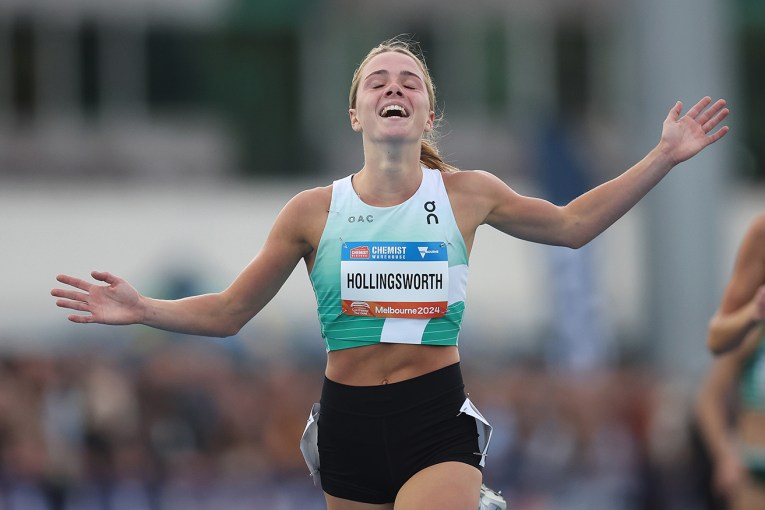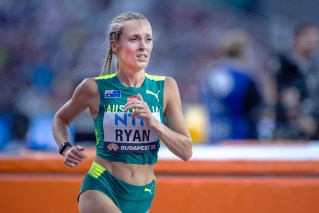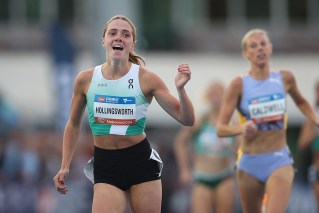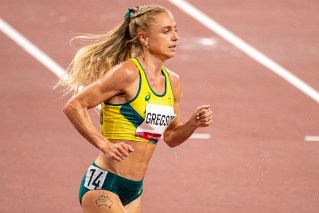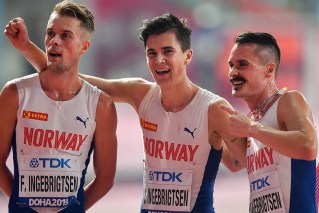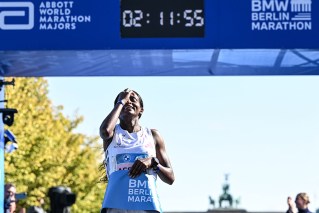Celebrating four minutes that changed the world
Sixty years later, Roger Bannister is busy reliving the four minutes that still endure as a transcendent moment in sporting history.
It was on a wet, blustery day – May 6, 1954 – that the lanky English medical student became the first runner to break the fabled 4-minute barrier in the mile (1600m), a feat that many had thought was humanly impossible.
Helped by two pace makers, the 25-year-old Bannister completed four laps around a cinder track in Oxford in 3 minutes, 59.4 seconds, a milestone that captured the world’s fascination and still resonates today.
“It was a target,” Bannister, now 85 and fighting Parkinson’s disease, said in an interview with The Associated Press at his Oxford home, a short distance from the Iffley Road track where he made his name.
“University athletes had been trying for years and it just didn’t seem to be capable of being broken. There was this magic about four symmetrical laps of one minute each.
“It was just something which caught the public’s imagination. I think it still remains something that is of interest and intrigue.”
Bannister’s record lasted just 46 days and he considers his victory over Australian rival John Landy a few months later as his greatest running exploit.
Yet, as the 60th anniversary attests, Bannister’s 3:59.4 remains part of track and field lore, a symbol of boundary-busting endurance.
It’s only a slice of Bannister’s life story. He retired from running at the end of 1954 and went on to pursue a long career in neurology that he considers more significant than anything he accomplished on the track.
“Medicine without a doubt,” Bannister said when asked about his proudest achievement.
“I wouldn’t claim to have made any great discoveries, but at any rate I satisfactorily inched forward in our knowledge of a particular aspect of medicine. I’m far more content with that than I am about any of the running I did earlier.”
The man knighted Sir Roger in 1975 is slowing while coping with the effects of Parkinson’s, a neurological condition that falls under his medical specialty.
“I know quite a bit about it, which is both helpful and unhelpful,” Bannister said, sitting in his living room lined with photos and mementoes of both his careers.
“But I’m 85 and something has to happen.”
Bannister’s right ankle was shattered in a car accident in 1975 and he has been unable to run since then. Now, he walks with crutches inside his home and uses a wheelchair outdoors.
Hundreds of athletes have run the mile in less than 4 minutes since Bannister did it and the world record has been broken 18 times since then. The current mark of 3:43.13 was set by Morocco’s Hicham El Guerrouj in 1999.
The next barrier in the sport? Bannister believes the 2-hour mark in the marathon will be broken in the next few years. The fastest time stands at 2:03.23, run by Kenya’s Wilson Kipsang in Berlin in 2013.
“It involves a 2 per cent improvement,” Bannister said.
“It has to be run on a day with the right temperature and on a course which isn’t too hilly, preferably a course which is a single line with the wind at your back all the way. It’ll be done.”
Bannister and his wife of 58 years, Moyra, will mark the May 6 anniversary at Oxford University with family and friends – a lunch at Exeter College, where Bannister enrolled in 1946, and a ceremony at Vincent’s Club, an elite 150-year-old sports club.
Missing will be Bannister’s pace makers, Chris Brasher and Chris Chataway. Brasher, who founded the London Marathon, died in 2003 at the age of 74. Chataway passed away in January at 82.
“I miss them very much,” Bannister said. “We used to meet on the anniversary on May 6 with our wives and sometimes with children and have a kind of party and reflect.”
Bannister has just come out with a new autobiography, “Twin Tracks.”
The book – which grew out of letters to his 14 grandchildren – traces his family’s origins in Lancashire in northwest England, his years growing up in the London borough of Harrow and the story of his athletic, medical and academic life.
“If I don’t write my autobiography, there may be biographies written, and I think I’d rather like to tell it myself,” he said.
Bannister went to the 1952 Helsinki Olympics as a favourite in the 1,500 metres – the shorter metric mile distance run in the Olympics – but struggled with the addition of an extra day of heats and finished only fourth.
Retirement plans were put aside and Bannister decided to run for two more years and chase the 4-minute mark.
Swedish runner Gunder Hagg’s mile record of 4:01.4 had stood since 1945. Landy and Wes Santee of the United States had both run 4:02 and were competing with Bannister to be the first under 4 minutes.
“At one point, Landy said, ‘It’s like a brick wall. I’m not going to attempt it again,”‘ Bannister said.
“I, as a medical student, knew there wasn’t a brick wall. If you could run it in 4 minutes and 2.2 seconds, then you would find somebody else somewhere who trained a little better, had better conditions on the day, was able to use the pace judgment better, and they could do it. That was the frame of mind in which I approached it.”
Bannister chose to make his attempt during a meet between Oxford and the Amateur Athletic Association. He lined up Chataway and Brasher as pace setters. The weather was cool and windy. Bannister only decided to go ahead with the race after the gusts died down.
After going through the first three laps in 3:01, Bannister knew he had to run the final lap in under 59 seconds. He described the final, gruelling 300 yards in his book:
“I felt at that moment that it was my chance to do one thing supremely well. I drove on, impelled by a combination of fear and pride. … Those last few seconds seemed an eternity. …. I leapt at the tape like a man taking his last desperate spring to save himself from a chasm that threatens to engulf him. Then my effort was over and I collapsed almost unconscious, with an arm on either side of me.”
When Norris McWhirter read out the winning time, the crowd drowned him out when he announced the first number: “3….”
Landy lowered the record to 3:57.9 six weeks later in Finland. The two men then went head-to-head in August in the “Mile of the Century” or “Miracle Mile” at the Empire Games in Vancouver.
Bannister passed the Australian on the final bend and won in 3:58.8. Landy clocked 3:59, the first time two runners went under 4 minutes in one race.
Bannister capped his remarkable year by winning the 1,500m at the European championships in Berne. He then retired to go full-time into medicine.
“By then,” Bannister said. “I could feel that honour was satisfied.”
